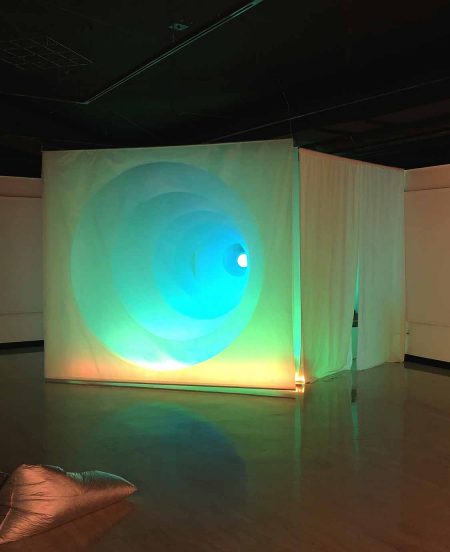A Brief Elaboration of a Tube is equal parts local soundscape fiction and monument to reflection and introspection.
Huff Gallery is located in the basement of the library of Spalding University (Louisville, Kentucky); a suitable location for an installation as subversive and introspective as this. As the viewer enters the space from the main stairwell, they are introduced to an ambient cool light source and a droning sound whose pitch, coincidentally, overwhelmed my friend who had recently experienced a moderate head injury— a detail I found intriguing. Though the droning sound and the radiant light were welcome introductions to the space, that wasn’t the highlight of the experiential installation.
Nestled in the rear corner of the gallery is a large installation composed of large plastic sheeting, conduit, and LED lights. The plastic sheets are hung with concentric circles cut from their center, allowing the light from the LEDs installed at the bottom of the sheet (also acting as a weight for the suspended material) to round out and bounce off and around each other, creating a range of colors. The arrangement of colors evokes a range of emotive responses, from soothing and melodic to trepidatious and queezy, depending on the moment. When seated (in metallic beanbag chairs assembled by Quesenberry) directly in front of the installation; the viewer is misled into perceiving that there rests a tube within these suspended sheets—somehow weightless. Alas, it’s just an example of how gullible our rods and cones—or brain—are. The void can hold whatever the viewer projects onto it. “This installation draws on the artists’ shared interests in repetiton, minimalism, and an oblique approach to meaning. While individual elements of the light and sound patterns repeat, they are constantly rearranged in relation to one another, creating nearly endless recombinations”.
“Through the play of materials, surfaces, and technologies, [Quesenberry] works to explore the boundaries of visual perception, memory’s effect on present experience (a truism of the collaboration), and how these elements relate to ideas of certainty”. It “frequently considers the many ways that certainty is illusive and ambiguity is compelling”. The open-endedness of Quesenberry’s contribution leaves the viewer’s perceptual state available for further interpretation of the entire exhibition.
Observing deeply into the very end of the tube whilst maintaining auditory focus on the sound installation, I began to contemplate the Bardo Thodol (the intermediate state in between death and rebirth as referenced in Liberation Through Hearing During the Intermediate State, better known as the Tibetan Book of the Dead) and my current location smack dab in the middle of the American Rustbelt and Kentucky Appalachia. I’ll go over the reference to location in a moment, but first, belief holds that in the moment right after death, the individual has the opportunity to experience a sense of oneness with the universe void of reference to any binding discourse with reality—it’s similar in philosophy to meditative practices practiced within isolation chambers and it’s a philosophy that was sought out to be replicated in similar ways within locations such as the Rothko Chapel and James Turrell’s Roden Crater—because of their lack of reference and focus on introspection, the viewer is forced to fill in the gaps with their own references, or more likely—memories. Turns out, memories— much like visual and auditory perception— are very powerful and with minimal output can cultivate a powerful response.
“Rosenblum’s compositions and installations use field recordings, instruments, and electronics to locate and dislocate the listener in minimally-processed soundscapes. Juxtapositions between familiar and unfamiliar, between natural and anthropogenic sound, and between intentional and unintentional rhythms and harmonies are recurring themes. His works encourage active and engaged listening, but do not offer intentional narratives.” Rosenblum’s composition presented here consists of sounds collected from around the region, but primarily from Bernheim Arboretum and Research Forest. The most primary and overwhelming sound is a consistent drone that was recorded near a factory; it’s an ambiguous sound— one that is round, deep, and pushes its way around your ear canal. Interlaced are sounds of birds chirping and crewing, brushing leaves, and sounds of trains.
Obviously this is a personal attribution and observation—not necessarily based in critique— the composition physically feels like the Midwest / Kentucky Appalachia. Much like how smell can relocate your sense of location, sound cultivates memories, and thus emotions, that are incredibly instinctual and bound in self-referential experience. For me, there is an expressed feeling of dissolution, forgotten-ness, and ironically—nostalgia nestled deep within the architecture of Rosenblum’s soundscape. I recently was a care-taker for an ill parent who resided outside of Charlestown, Indiana and as I drove home each night in the silence after wrapping up an emotionally exhaustive visit— down a painfully long stretch of terribly flat road with the windows rolled down— I could swear that I consumed a sound that was eerily close to Rosenblum’s composition. In the moment it made me feel completely numb, which was perfectly welcome. Sitting within the safety of the gallery, it was comforting to have that sound handed back to me for reflection.
It’s bizarre how the most ambiguous works can instigate re-evaluation of tremendously specific experiences— proving that contemplation matters— and there lies the highlight of this installation / collaboration.
Unfortunately this exhibit will be closed by the time we at Aeqai publish this review, but it absolutely deserved a moment for thought, so here we are.
—Megan Bickel

